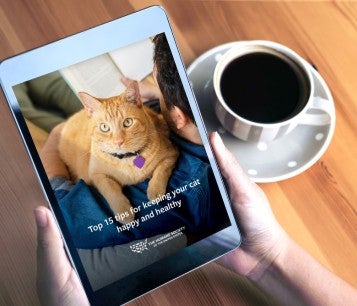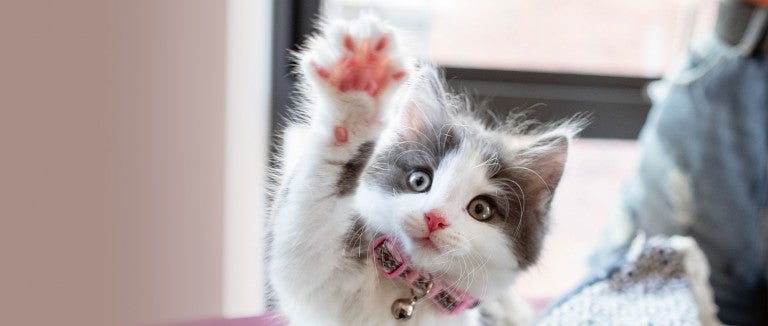Cats lack the facial expressiveness of dogs, they’re generally quieter and their behaviors can be harder to interpret—but this doesn’t mean that the feline mystique is impenetrable. You can better understand your furry friend by paying attention to their vocalizations, body postures and daily routines. In time, you may become so attuned to your kitty’s personality and habits that you’re able to detect subtle changes in their mood and even recognize health problems before physical signs of illness appear.
Vocalizing
You'll learn a lot when you can interpret your cat's wide vocabulary of chirps and meows. They'll tell you when they're hungry, when they're feeling affectionate and if they're feeling threatened or in pain.
While some cats rarely make a peep, others won’t let you get a word in edgewise. Kittens who are handled often and well socialized may turn into more vocal adults and certain breeds, like Siameses and Abyssinians, are loquacious by nature.
Cats can also become increasingly vocal as they age. Two possible reasons for this are age-related dementia and deteriorating eyesight. A cat who feels anxious or confused may meow to seek reassurance. Hearing loss can also cause a kitty to vocalize louder than usual because they can’t determine their volume. (Any pronounced behavior change should trigger a trip to the vet to make sure your cat isn’t ill or in pain.)
- Meowing is all-purpose; your cat may be using "meow" as a greeting, a command, an objection or an announcement. Some people have observed their cats walking around the house meowing to themselves.
- Chirps and trills are how a mother cat tells their kittens to follow them. Aimed at you, it probably means your cat wants you to follow them, usually to their food bowl. If you have more than one cat, you'll often hear them converse with each other this way.
- Purring is usually a sign of contentment. Cats purr whenever they're happy, even while they're eating. Sometimes, however, a cat may purr when they're anxious or sick, using their purr to comfort themselves, like a child sucking their thumb.
- Growling, hissing or spitting indicates a cat who is annoyed, frightened, angry or aggressive. Leave this cat alone.
- A yowl or howl (they sound like loud, drawn-out meows) tells you your cat is in some kind of distress—stuck in a closet, looking for you or in pain. Find your cat if they're making this noise. However, in unaltered cats, these sounds are part of mating behavior. If your cat is elderly, they may howl because they're disoriented, especially if suffering from a cognitive disorder, such as dementia.
- Chattering, chittering or twittering are the noises your cat makes when they're sitting in the window watching birds or squirrels. It usually translates to excitement ... or they may be contemplating snack time.
Sign up to receive our exclusive e-book full of important information about keeping your cat healthy and happy.

Body language
Does your cat arch their back up to meet your hand when you pet them? This means they're enjoying this contact with you. Do they shrink away under your slightest touch? Save the petting for later; they're not interested right now.
Pay attention to your cat's eyes, ears, body and tail—they're all telling you something. Here are some basic (though sometimes contradictory) clues:
Ears
- Forward: Alert, interested or happy
- Backward, sideways, flat ("airplane ears"): Irritable, angry or frightened
- Swiveling: Attentive and listening to every little sound
Eyes
- Pupils constricted: Offensively aggressive, but possibly content
- Pupils dilated (large): Nervous or submissive (if somewhat dilated), defensively aggressive (if fully dilated), but possibly playful
Tail
- Erect, fur flat: Alert, inquisitive or happy
- Fur standing up: Angry or frightened
- Held very low or tucked between legs: Insecure or anxious
- Thrashing back and forth: Agitated; the faster the tail, the angrier the cat
- Straight up, quivering: Excited, really happy or, if your cat hasn't been neutered or spayed, they could be getting ready to spray something
Body
- Back arched, fur standing up: Frightened or angry
- Back arched, fur flat: Welcoming your touch
- Lying on back, purring: Very relaxed
- Lying on back, growling: Upset and ready to strike
Rubbing
When your cat rubs their chin and body against you, they're telling you they love you, right? Well, sort of. What they're really doing is marking their territory. You'll notice that they also rub the chair, the door, their toys and everything in sight. They're telling everyone that this is their stuff, including you.
Kneading
This is sometimes called "making biscuits," because the cat works their paws on a soft surface as if they're kneading bread dough. It's a leftover behavior from nursing, when they massaged their mother's teats to make milk flow. Your cat does this when they are really happy.
The Flehmen response
Have you noticed times when your cat—perhaps while sniffing your shoe—lifts their head, opens their mouth slightly, curls back their lips and squints their eyes? They're not making a statement about how your shoe smells, they're gathering more information.
Your cat's sense of smell is so essential to them that they actually have an extra olfactory organ that very few other creatures have, the Jacobson's organ. It's located on the roof of their mouth behind their front teeth and is connected to the nasal cavity.
When your cat gets a whiff of something really fascinating, they open their mouth and inhale so that the scent molecules flow over the Jacobson's organ. This intensifies the odor and provides more information about the object they're sniffing.
A key to your cat's moods
Wondering if your cat is happy, meditating or having a bad day? Here's are some tips:
- Content: Sitting or lying down, eyes half closed, pupils narrowed, tail mostly still, ears forward and purring—a really happy cat will often knead on a soft surface.
- Playful: Ears forward, tail up, whiskers forward and pupils somewhat dilated—playing is hunting behavior; your cat may stalk their prey (a toy, a housemate or you), then crouch down with their rear end slightly raised. A little wiggle of the butt, then ... pounce! Your cat will grab their prey, bite it, wrestle it the floor and kick it with their hind feet.
- Irritated or overstimulated: Pupils dilated, ears turned back and tail twitching or waving—your cat may growl or put their teeth on you as a warning to cease and desist. Intense play can quickly turn into overstimulation in some cats, resulting in biting and scratching.
- Nervous or anxious: Ears sideways or back, pupils dilated and tail low or tucked between legs—your cat may slink through the house close to the floor, looking for somewhere to hide. They may turn their face to the wall to shut the world out.
- Frightened or startled: Think Halloween cat—ears back and flat against their head, whiskers back, back arched, fur standing on end and tail erect or low. They may yowl, growl, hiss and spit.
- Defensive: Crouched, ears flattened, whiskers back, tail between their legs or wrapped around their body and pupils dilated—they may meow loudly, growl, hiss and spit.
- Angry, aggressive: Ears back, pupils very constricted and their tail may be up or down with the fur standing on end—an aggressive cat will stare down another cat and growl or yowl until the other cat gives way. Cats don't really want to fight; they prefer standoffs, but this can progress to fighting if one of the cats doesn't back down.

